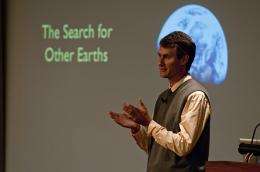Is another Earth out there?

(�鶹��ԺOrg.com) -- In the search for another Earth, "the stage is only just coming into view" as new mega-telescopes come online, but there is plenty of room for amateurs with less sophisticated telescopes to help in the planet hunt, too, according to noted astronomer Greg Laughlin, who spoke at the University of Delaware on Wednesday, Oct. 19.
Laughlin, professor and chair of the astronomy department at the University of California Santa Cruz, has been involved in the discovery of a number of plants outside our solar system, called extrasolar planets or “exoplanets.”
He shared some of his findings and the science behind them with an audience of more than 200 at the Harcourt C. “Ace” Vernon Memorial Lecture at UD’s Clayton Hall Conference Center.
More than 500 exoplanets have been detected by observers so far -- and the discoveries have been made by both professional astronomers and amateur observers, Laughlin said. However, many of the new planets discovered exhibit eccentric elliptical orbits “without much sideways momentum” compared to the “almost perfect circle” of Earth’s orbit.
“It’s extremely common for planets to be orbiting nearby stars, and our solar system is just one architecture out there,” Laughlin said. “Strange ones are the norm.”
One of the discoveries Laughlin has been involved in, HD149026b, has an orbital period of 2.5 days, or one weekend long.
“What’s amazing is, you’d think it would take the very best telescopes in the world, but a friend, Ron Bissinger, the CEO of a biotech company, observed it in his backyard observatory,” Laughlin noted.
Another planet, HD80606b, takes 111 days to orbit its sun-like star. But it ventures so close to its star that the planet heats up into a glowing fiery-red orb.
Laughlin periodically reminded the audience that some of the mysteries of the heavens are within our reach.
To illustrate his point, he showed a photograph of the sky with a crescent moon and two power lines visible off to one side. Toward the top edge of the photo was a white dot — the planet Venus. As he enlarged it to view the individual pixels, the smudgy dot appeared to have something in front of it, “and it’s completely not clear what it is,” Laughlin said.
Laughlin compared his view of Venus taken with a 5-megapixel camera to the view that Galileo saw in the early 1600s, as the explorer first used a telescope to look at objects in the sky. Galileo’s observations showed that Venus was orbiting the sun and not the Earth because he could see the changing phases of the planet.
Yet the whole sense that we’re on a planet in space was only brought home a few decades ago by the Apollo astronauts. “It wasn’t till the astronauts left Earth’s orbit that it sunk in that we as a species were on a planet hanging in space,” Laughlin noted.
Now, with sophisticated telescopes like NASA’s Kepler and the James Webb Space Telescope (set to launch in 2018), humanity can continue with a quest that Christiaan Huygens, began in the late 1600s, when he was the first to look for exoplanets.
Among the gas giants, the super-hot planets with short-period orbits, and ice giants, observers hope to find habitable, terrestrial planets.
“We’re now down to where we can detect Earth-like worlds,” Laughlin said.
“It’s opening a new chapter in our intellectual development as a species -- the realization that other planets like ours are out there orbiting the stars,” he noted. “Tens of billions of stars in the galaxy could harbor these planets.”
The Transit Search Project, which Laughlin leads, is seeking public participants to help with the extrasolar planet search. The project’s website is .
Provided by University of Delaware





















